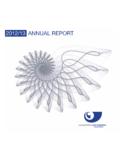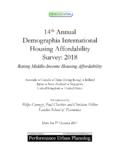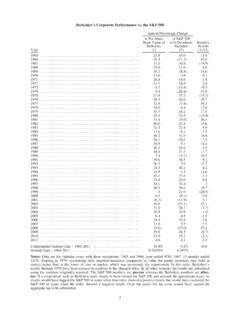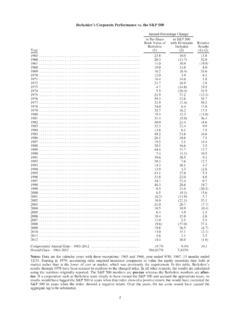Transcription of NYC Green Infrastructure Plan
1 NYC Green Infrastructure Plan2011 UpdateMichael R. Bloomberg, MayorCarter Strickland, CommissionerNYC Green Infrastructure PlaniDear Friends:One of the goals of our Administration s extensive environmental initiative, PlaNYC, is to restore coastal ecosystems by improving the quality of our waterways. Today, New York Harbor is the cleanest it has been in more than a century, thanks largely to the $9 billion that the City has invested in water quality since 2002. However, tough economic times require us to budget and spend especially responsibly. That is why we continue to work with our federal and state regulators to reform mandates and allow the City to invest in the Infrastructure we need in the most cost-effective ways NYC Green Infrastructure Plan, which changes the way the City manages rain-related pollution, is a major part of this effort.
2 The joint economic and environmental analysis contained within the plan has shown that the cost of new Green Infrastructure and more efficient water management systems would save billions of dollars over more traditional fixes. By using Green Infrastructure technology to keep stormwater out of our sewers, we can reduce sewer overflows and promote the sustainability policies that will make New York greener and greater and save taxpayers money, State has given us a Green light to move forward with our plan, and we ve backed up our proposal with significant resources $ billion over the next 20 years. Implementing the plan will require ongo-ing collaboration between key City agencies and the many civic leaders who are committed to improv-ing our waterways.
3 Our implementation of the NYC Green Infrastructure Plan will ensure that we all remain focused on the same goal: a cleaner and more accessible harbor that continues to benefit our great City. Sincerely, Michael R. Bloomberg MayorMichael R. Bloomberg MayorDear Friends:From our pioneering work creating wetlands to handle stormwater in Staten Island s Bluebelts to our watershed management program that protects our drinking water from the Catskill Mountains, DEP has sought to use natural systems to perform our work where effective and economical.
4 Together those programs have saved DEP ratepayers billions of dollars in avoided hard Infrastructure such as storm sewers and filtration plants, while preserving large tracts of natural NYC Green Infrastructure Plan continued that tradition by demonstrating that the widespread adoption of Green roofs, bioswales, and other Green Infrastructure will absorb or delay runoff from storms, keep it out of our combined sewer system, and reduce the combined sewer overflows that are the primary source of pathogens in New York Harbor. In addition, we predicted that this approach would save billions of dollars and would also beautify our neighborhoods, increase property values, and improve air quality.
5 On March 13, 2012, DEP and the New York State Department of Environmental Conservation (DEC) finalized an historic agreement that incorporates an iterative, adaptive management approach, committing DEP to: Construct Green Infrastructure citywide that will manage 10% of the runoff from impervious surfaces by 2030; Construct $2 million of Green Infrastructure in three neighborhood demonstration areas; Construct $ billion in grey Infrastructure , of which $ billion has already been incurred; and Publish 11 Long Term Control Plans for the control of combined sewer overflows by exchange, DEC has eliminated approximately $ billion in grey Infrastructure projects, and agreed to defer another $2 billion in additional grey Infrastructure that had been proposed, providing DEP with the necessary time to build and monitor Green Infrastructure didn t wait for this consent order to be finalized before getting to work.
6 In 2011 , the City created an interagency Green Infrastructure Task Force to identify opportunities to add Green Infrastructure to capital projects, created an Office of Green Infrastructure within DEP, launched a Green Infrastructure Grant Program, developed standard designs for Green Infrastructure , signed a memorandum of agreement for the maintenance of Green Infrastructure , and facilitated the creation of a Green Infrastructure Steering Committee comprised of community groups and other interested parties. This report provides details about those developments and we can implement the NYC Green Infrastructure Plan and work towards a greener, greater New York.
7 Sincerely, Carter H. Strickland, Jr. CommissioneriiCarter H. Strickland CommissionerContentsIntroductIon ..1 Goals and achIevements ..31. BuIld cost-eFFectIve GreY Infrastructure ..5 Paerdegat Basin CSO Detention Facility ..5 Alley Creek CSO Detention Facility ..5 High Level Storm Sewers ..6 Tallman Island System Wet Weather Maximization ..62. oPtImIZe the eXIstInG WasteWater sYstem ..7 Interceptor Improvement Program ..7 Tide Gate Maintenance Program ..8 Demand Side Management.
8 83. control runoFF From 10% oF ImPervIous surFaces throuGh Green Infrastructure ..9 Green Infrastructure Task Force ..9 Stormwater performance standard and opportunities in new development ..9 Green Infrastructure Retrofits ..10 Jamaica Wastewater Treatment Plant Green Roof ..11 High Density Residential Green Infrastructure : The Bronx River Houses ..11 Right-of-Way Bioswales and Greenstreets ..13 North and South Conduit Bioretention Zone ..14 Select Bus Service Stations ..14 Neighborhood Demonstration Areas ..15 Rain Barrel Giveaway Program ..16 Green Infrastructure Grant Program ..17iii4. InstItutIonalIZe adaPtIve manaGement, model ImPacts, measure ProGram elements, and monItor Water QualItY.
9 19 Institutionalizing Adaptive Management ..19 Watershed-Level Planning ..20 Modeling Landside Infrastructure and Water Quality Modeling ..20 Measuring Program Performance and CSOs ..21 Monitoring Ambient Water Quality ..21 Research and Development for Measuring CSOs ..215. enGaGe and enlIst staKeholders In stormWater manaGement ..22 Notification Systems ..22 Green Infrastructure Citizen s Group ..22 Green Infrastructure Steering Committee ..22 Fostering Stewardship of Green Infrastructure ..23 Long Term Control Plans ..24 Green Infrastructure case studIes ..25 Enhanced Tree Pits and Streetside Infiltration Swales in the Right of Way ..26 Spring Creek Bus Depot Parking Lot Pilot.
10 31 Blue Roof Comparison Study on 1201 Metropolitan Avenue ..35 Blue/ Green Roof Study on 118 ..40aPPendIX a: cso orderaPPendIX B: standard BIosWale desIGnsiv1 On September 28, 2010, the City released the NYC Green Infrastructure Plan (the Plan), which set forth a series of initiatives and op-portunities that dramatically change the way we man-age stormwater. New York City, like other older urban centers, is largely serviced by a combined sewer sys-tem where stormwater and wastewater are carried through a single pipe. Even though treatment plants are designed to treat and disinfect twice the dry weath-er flow, during heavy storms the system can exceed its capacity and is designed to discharge a mix of storm-water and wastewater called combined sewer over-flow or CSO into New York Harbor in order to prevent treatment plants from becoming compromised.

















